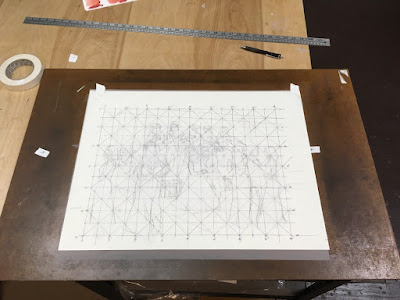For the past week or so, I've been experimenting with a different approach and painting technique in the studio. One of the artists that has caught my eye is Jeremy Lipking. His paintings have a very quiet feeling to them. Mine generally do, too, so I wanted to see what I could learn of his approach that might come over to mine.
I chose two of Lipking's paintings as inspiration: Canoe and Sagebrush.
There were lots of things that played into the feeling in both paintings:
- A solitary figure. Most of his figures are looking away. This anonymizes them to an extent and the viewers can imagine themselves in the painting's environment.
- Lots of flat areas of color: the lake in Canoe and the sky in Sagebrush, for example.
- Very sharp edges - the canoe especially, but the blanket and ridgetop in Sagebrush are sharper than they look.
- Use of value contrasts to focus attention. The figure in the canoe is almost not noticed at first, but the dark canoe against the brilliant light, especially with the sharp edges (even in the reflections) demands your attention. In Sagebrush, the high value contrast between the light sky and dark head draws your eye immediately.
- Use of light and dark shapes as compositional elements. In Canoe, there are essentially two shapes: light and dark, in a horizontal arrangement. Sagebrush has a wider range of values, but it's basically a T-shape composition, with the blanket against the darker sage, the brilliant red mountain in the distance, and then the light sky with dark head.
- And they're really finely detailed. These are almost photographically accurate paintings, and when you enlarge the images, you see very fine detail in face, hair, even the texture of the blanket and sage.
This exercise was "in the spirit of Lipking", not a copy, so I used a photo of one of my favorite models. It was taken in the studio, but I wanted to put her outside, using a T-shaped composition. And I borrowed heavily from the Canoe's setting. Here's how it looked after day 1:
It's okay, kinda meh. Alright, a lot meh. I went back the next day and reworked it:
So what did I do? I turned her head. It made it feel a bit more relaxed and it made her a bit more anonymous. I darkened the hills and reflections significantly, which better matches what really happens around sunset. I put a lot more yellow into the sky and water to both lighten them up and warm the painting. I changed the foreground to bring more sky color to the bottom of the painting and to make it feel more real. I darkened her shadow and worked on the reflections from the robe. And I reworked the robe for more detail, a warmer color, and slightly darker value to make it stand out against the light from the water.
I learned a lot about Lipking's technique, even though mine comes nowhere close to his. The sky and water, for example, are built out of lots of small strokes of blue and yellow laid down next to and also dragged over each other. When two paint colors are thoroughly mixed together, they give one flat color. When colors are adjacent to each other, your eye does the mixing, but the result is richer. Kinda like chords in music as compared to single notes.
Most importantly, though, I learned that I really don't want to put paint on canvas the way he he does. I like a looser approach, where the individual strokes are obvious from well back. I get more energy that way. But the compositional items, like values and colors? Yeah. I can use those.



























